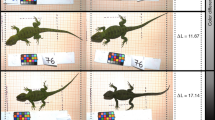Abstract
Research on intraspecific aggression has typically focused on dominant individuals, but a better understanding of the consequences and mechanisms of agonistic encounters requires a balanced perspective that includes knowledge of subordinate animal behaviors. In contrast to signals of fighting ability, signals of submission are an understudied component of agonistic communication that could provide important insights into the dynamics, function, and evolution of intraspecific competition. Here, I use a series of staged agonistic trials between adult male veiled chameleons Chamaeleo calyptratus to test the hypothesis that rapid skin darkening serves as a submissive signal to resolve agonistic activity. Concordant with this hypothesis, I found that losing chameleons darkened over the course of aggressive trials while winners brightened, and the likelihood of darkening increased when individuals were attacked more aggressively. Additionally, I found that the degree of brightness change exhibited by individual chameleons was tied to both overall and net aggression experienced during a trial, with chameleons who received high levels of aggression relative to their own aggression levels darkening to a greater extent than individuals receiving relatively less aggression. Lastly, I found that aggression increased for losers and winners prior to the onset of darkening by the eventual loser but that both chameleons reduced aggression after the losing chameleon began to darken. Based on the theoretical prediction that signals of submission should be favored when retreat options are restricted, I suggest that limited escapability imposed by chameleon morphology, physiology, and ecology favored the evolution of a pigment-based signal of submission in this group.






Similar content being viewed by others
References
Abu-Ghalyun Y, Greenwald L, Hetherington TE, Gaunt AS (1988) The physiological basis of slow locomotion in chamaeleons. J Exp Zool 245:225–231
Batista G, Zubizarreta L, Perrone R, Silva A (2012) Non-sex-biased dominance in a sexually monomorphic electric fish: fight structure and submissive electric signalling. Ethology 118:398–410
Bergman TJ, Beehner JC (2008) A simple method for measuring colour in wild animals: validation and use on chest patch colour in geladas (Theropithecus gelada). Biol J Linn Soc 94:231–240
Bowmaker JK, Lowe ER, Ott M (2005) The cone photoreceptors and visual pigments of chameleons. J Comp Physiol A 191:925–932
Bradbury J, Vehrencamp S (1998) Principles of animal communication. Sinauer, Massachusetts
Briffa M, Hardy ICW, Gammell MP, Jennings DJ, Clarke DD, Goubault M (2013) Analysis of animal contest data. In: Hardy ICW, Briffa M (eds) Animal contests. Cambridge University Press, New York, pp 47–85
Burrage BR (1973) Comparative ecology and behaviour of Chamaeleo pumilus (Gmelin) and C. namaquensis A. Smith (Sauria: Chamaeleonidae). Ann S Afr Mus 61:1–158
Bustard HR (1965) Observations on the life history and behavior of Chamaeleo hohnelii (Steindachner). Copeia 1965:401–410
Bustard HR (1967) The comparative behavior of chameleons: fight behavior in Chameleo gracilis Hallowell. Herpetologica 23:44–50
Cuadrado M (2000) Body colors indicate the reproductive status of female common chameleons: experimental evidence for the intersex communication function. Ethology 106:79–91
Cuadrado M (2001) Mate guarding and social mating system in male common chameleons (Chamaeleo chamaeleon). J Zool 255:425–435
Darwin C (1872) The expression of the emotions in man and the animals. Murray, London
R Development Core Team (2011) R: a language and environment for statistical computing. R Foundation for Statistical Computing, Vienna. ISBN 3-900051-07-0, http://www.R-project.org/
East ML, Hofer H, Wickler W (1993) The erect ‘penis’ is a flag of submission in a female-dominated society: greetings in Serengeti spotted hyenas. Behav Ecol Sociobiol 33:355–370
Eaton L, Sloman KA (2011) Subordinate brown trout exaggerate social signaling in turbid conditions. Anim Behav 81:603–608
Eberle AN (1988) The melanotropins: chemistry, physiology and mechanisms of action. Karger, Switzerland
Enquist M, Leimar O (1990) The evolution of fatal fighting. Anim Behav 39:1–9
Fischer MS, Krause C, Lilje KE (2010) Evolution of chameleon locomotion, or how to become arboreal as a reptile. Zoology 113:67–74
Forster GL, Watt MJ, Korzan WJ, Renner KJ, Summers CH (2005) Opponent recognition in male green anoles, Anolis carolinensis. Anim Behav 69:733–740
Hannes RP, Franck D, Liemann F (1984) Effects of rank order fights on whole-body and blood concentrations of androgens and corticosteroids in the male swordtail (Xiphophorus helleri). Z Tierpsychol 65:53–65
Harkness L (1977) Chameleons use accommodation cues to judge distance. Nature 267:346–349
Hogben LT, Mirvish L (1928) The pigmentary effector system. V. The nervous control of excitement pallor in reptiles. J Exp Biol 5:295–308
Höglund E, Balm PH, Winberg S (2000) Skin darkening, a potential social signal in subordinate artic charr (Salvelinus alpinus): the regulatory role of brain monoamines and pro-opiomelanocortin-derived peptides. J Exp Biol 203:1711–1721
Huhman KL, Moore TO, Mougey EH, Meyerhoff JL (1992) Hormonal responses to fighting in hamsters: separation of physical and psychological causes. Physiol Behav 51:1083–1086
Huntingford FA, Taylor AC, Smith IP, Thorpe KE (1995) Behavioural and physiological studies of aggression in swimming crabs. J Exp Mar Biol Ecol 193:21–39
Hurd PL, Wachtmeister CA, Enquist M (1995) Darwin’s principle of antithesis revisited: a role for perceptual biases in the evolution of intraspecific signals. Proc R Soc Lond B 259:201–205
Issa FA, Edwards DH (2006) Ritualized submission and the reduction of aggression in an invertebrate. Curr Biol 16:2217–2221
Karsten KB, Andriamandimbiarisoa LN, Fox SF, Raxworthy CJ (2009) Social behavior of two species of chameleons in Madagascar: insights into sexual selection. Herpetologica 65:54–69
Kelso EC, Verrell PA (2002) Do male veiled chameleons, Chamaeleo calyptratus, adjust their courtship displays in response to female reproductive status? Ethology 108:495–512
Koutnik DL (1980) Submissive signalling in mule deer. Anim Behav 28:312–313
Ligon RA, McGraw KJ (2013) Chameleons communicate with complex colour changes during contests: different body regions convey different information. Biol Lett 9:20130892
Lorenz K (1966) On aggression. Methuen, London.
Matsumura S, Hayden TJ (2006) When should signals of submission be given?—a game theory model. J Theor Biol 240:425–433
Molles LE, Vehrencamp SL (2001) Songbird cheaters pay a retaliation cost: evidence for auditory conventional signals. Proc R Soc Lond B 268:2013–2019
Nečas P (1999) Chameleons: Nature’s hidden jewels. Chimaira, Frankfurt
O’Connor KI, Metcalfe NB, Taylor AC (1999) Does darkening signal submission in territorial contests between juvenile Atlantic salmon, Salmo salar? Anim Behav 58:1269–1276
O’Connor KI, Metcalfe NM, Taylor AC (2000) Familiarity influences body darkening in territorial disputes between juvenile salmon. Anim Behav 59:1095–1101
Okelo O (1986) Neuroendocrine control of physiological color change in Chameleo gracilis. Gen Comp Endocrinol 64:305–311
Ott M, Schaeffel F (1995) A negatively powered lens in the chameleon. Nature 373:692–694
Øverli Ø, Harris CA, Winberg S (1999) Short-term effects of fights for social dominance and the establishment of dominant-subordinate relationships on brain monoamines and cortisol in rainbow trout. Brain Behav Evol 54:263–275
Peterson JA (1984) The locomotion of Chamaeleo (Reptilia: Sauria) with particular reference to the forelimb. J Zool (202: 1-42
Pike TW (2011) Using digital cameras to investigate animal colouration: estimating sensor sensitivity functions. Behav Ecol Sociobiol 65:849–858
Qvarnstrom A, Forsgren E (1998) Should females prefer dominant males? Trends Ecol Evol 13:498–501
Schuett GW, Harlow HJ, Rose JD, Van Kirk EA, Murdoch WJ (1996) Levels of plasma corticosterone and testosterone in male copperheads (Agkistrodon contortrix) following staged fights. Horm Behav 30:60–68
Stevens M, Párraga CA, Cuthill IC, Partridge JC, Troscianko TS (2007) Using digital photography to study animal coloration. Biol J Linn Soc 90:211–237
Stuart-Fox D (2006) Testing game theory models: fighting ability and decision rules in chameleon contests. Proc R Soc Lond B 273:1555–1561
Stuart-Fox DM, Johnston GR (2005) Experience overrides colour in lizard contests. Behaviour 142:329–350
Stuart-Fox DM, Moussalli A (2008) Selection for social signalling drives the evolution of chameleon colour change. PLoS Biol 6:e25
Stuart-Fox DM, Firth D, Moussalli A, Whiting MJ (2006) Multiple signals in chameleon contests: designing and analysing animal contests as a tournament. Anim Behav 71:1263–1271
Summers CH, Korzan WJ, Lukkes JL, Watt MJ, Forster GL, Øverli O, Höglund E, Larson ET, Ronan PJ, Matter JM, Summers TR, Renner KJ, Greenberg N (2005) Does serotonin influence aggression? Comparing regional activity before and during social interaction. Physiol Biochem Zool 78:679–694
Van Dyk DA, Evans CS (2008) Opponent assessment in lizards: examining the effect of aggressive and submissive signals. Behav Ecol 19:895–901
Walton BM, Bennett AF (1993) Temperature-dependent color change in Kenyan chameleons. Physiol Zool 66:270–287
Acknowledgments
I thank Megan Best, Sarah Bruemmer, Brianna Bero-Buell, and Andrea Carpenter for their invaluable assistance with experimental procedures, data collection, and dedicated chameleon care. I thank the Animal Behavior Society, the American Society for Ichthyologists and Herpetologists, the ASU chapter of Sigma Xi, and the ASU Graduate and Professional Students Association for financial support of this research. I also thank my parents, David and Sandy Ligon, as well as Richard and Janet Steele and two anonymous donors for their generous financial support to this project. I thank my advisor Kevin McGraw, Dale DeNardo, and members of the McGraw lab group for input that greatly improved this manuscript. I also thank my wife, Veronica Ligon, for her support throughout this project.
Author information
Authors and Affiliations
Corresponding author
Additional information
Communicated by E. Fernandez-Juricic
Rights and permissions
About this article
Cite this article
Ligon, R.A. Defeated chameleons darken dynamically during dyadic disputes to decrease danger from dominants. Behav Ecol Sociobiol 68, 1007–1017 (2014). https://doi.org/10.1007/s00265-014-1713-z
Received:
Revised:
Accepted:
Published:
Issue Date:
DOI: https://doi.org/10.1007/s00265-014-1713-z




